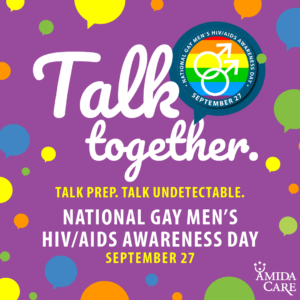National Gay Men’s HIV/AIDS Awareness Day: Stopping HIV Together

The COVID-19 pandemic has had a profound impact on the U.S. population, and the effects are far-reaching. With several health centers closed and/or with reduced staff and hours during the pandemic, we don’t yet know the full extent of COVID-19’s impact on the health of the LGBTQ community, but it has highlighted the need to maintain the momentum to end the HIV/AIDS epidemic.
September 27 is National Gay Men’s HIV/AIDS Awareness Day (NGMHAAD), bringing attention to the impact of HIV/AIDS on gay and bisexual men, particularly men of color, who have been hit the hardest by the epidemic. It’s an important reminder to promote HIV testing and encourage those living with HIV to adhere to treatment to improve their health and reduce the likelihood of transmitting the virus to others.
According to the Centers for Disease Control (CDC), gay and bisexual men make up approximately 70% of new U.S. HIV diagnoses, with 37% of those cases among African American men who have sex with men (MSM), 29% Latinx MSM, and 28% white MSM. Nationally, Black MSM are more affected by HIV than any other population in the U.S.
In New York City, the numbers are similar, with MSM accounting for 54% of all new diagnoses, and 69% of new diagnoses among men. Of all men newly diagnosed with HIV, 80% were Black or Latinx MSM. Unlike national figures, however, in NYC there were more new HIV diagnoses among Latinx MSM (442) than among Black men (364) in 2018, highlighting the importance of outreach in New York City’s Latinx communities. Though the numbers of new HIV diagnoses among MSM in the city decreased overall between 2014 and 2018, there is still more work to be done:
Testing: The only way to know for sure whether you have HIV is to get tested. If you test positive for HIV, you can take necessary steps to get treatment, care and support services, which will help you live a longer, healthier life. You can also take the necessary precautions to prevent transmission to others.
Prevention: Today, more tools than ever are available to prevent HIV. It’s important for men at risk to discuss testing, condoms, pre-exposure prophylaxis (PrEP), and treatment so that they can take action to protect themselves and their partners.
Treatment: Medications for HIV have improved tremendously over the past several years. It’s crucial that people with HIV access treatment as soon as possible for treatment to be most effective. The immediate initiation of HIV therapy upon diagnosis, Rapid Start, has been shown to suppress the virus quickly, decrease risk of transmission, and improve overall outcomes.
Stigma: Homophobia still exists in in some communities, even in New York City, resulting in barriers to prevention, diagnoses, and treatment. Education and support can help fight the harmful effects of stigma.
Advocacy: The pandemic has caused major financial hardship for many community health centers in New York, resulting in staff and budget cuts. It’s crucial that Affordable Care Act (ACA) Medicaid expansion and continued long-term grant funding is preserved to ensure that ending the epidemic is still on track for the near future!
Resources
CDC Let’s Stop HIV Together Initiative
GMHC
New York City Department of Health & Mental Hygiene
